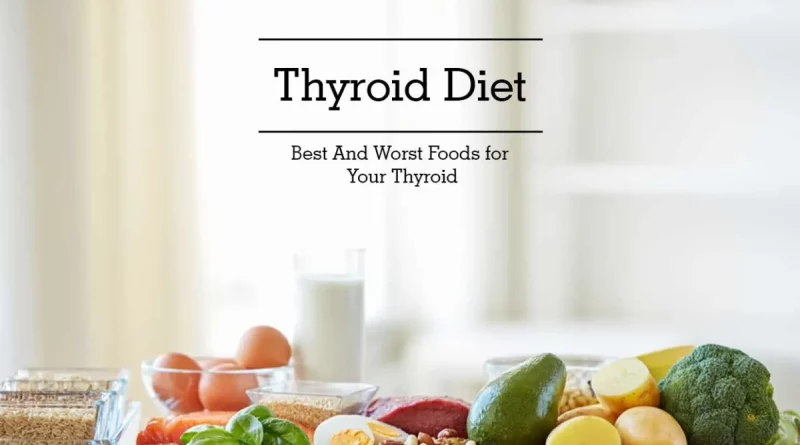Eating For Your Thyroid
Thyroid imbalance is much more common today than it was even a decade ago. Despite all the information available through books, magazines, and articles like this one, more work needs to be done in educating the public and the medical community. It has become a hidden epidemic throughout the United States so it is important to learn how to eat well to support your thyroid.
The best eating plan for someone dealing with any thyroid disorder is one that contributes to their overall health. This means low-glycemic, high-complex carbohydrates, low-fat diet. Eating foods that fall into this category will cause you to lose weight and keep it off for good. The best part is you will stay full longer, intake fewer calories and receive a good amount of vitamins, minerals, trace elements, and fiber.
This means staying away from refined sugars and simple sugars which cause sugar to enter the bloodstream faster and produce a higher rise in blood sugar. The higher the blood sugar levels after food is consumed, the higher the insulin levels. The GLYCEMIC INDEX is defined as how high your blood sugar goes up in response to eating a particular food. The higher the rise of blood glucose, the higher the food’s glycemic index.
You need to learn how to reduce the number of simple sugars you eat per day as well as learn how to lower the glycemic load at every meal. Here are some tips and suggestions on how to do just that:
1. Replace white bread with 100% WHOLE GRAIN BREAD which has a lower glycemic index.
2. Increase your consumption of OATS and BARLEY.
3. Eat foods like whole grains, barley, nuts, pumpernickel bread, and dried legumes which have a much lower glycemic index.
4. Avoid white bread, white potatoes, chips, sweetened breakfast cereals, sweet potatoes, sweet corn, white rice, cookies, biscuits, and buckwheat – all of which have an intermediate glycemic index.
5. Choose leafy greens, whole grain bread, unsweetened crackers made from rice, and unsweetened muffins.
6. Avoid cookies, cakes, ice cream, doughnuts, and pastries which are full of refined sugars and fat.
To lower the glycemic index of your meals, increase your fiber content. This will raise the efficiency of insulin, keep you full longer, and will reduce your caloric intake naturally. If you do eat cereal, choose whole-grain varieties that will give you more calcium, fiber, iron, folic acid, Vitamin C, and zinc. They will cause you to eat less fat and cholesterol and help you lose weight by eating more fiber.
Even though fruits are rich in fiber, vitamins, and antioxidants, they are quite high in simple sugars. For this reason, keep your fruit intake to 2 servings per day. Eat fruits with the lowest glycemic index which are apples and organic berries. When it comes to fat, you want to avoid fats that come from meat and dairy as well as fats that are solid at room temperature. If you eat too much fat, you will continue to be hungry, and as a result, eat more calories.
Your body can adjust its metabolism when you eat good-quality proteins and carbohydrates. It cannot do this if you eat too much fat. Fat gets absorbed from your intestines and goes straight to your fat cells for storage. If you reduce fat in your diet, you will lose weight even if you eat the same amount of calories. In other words, if you reduce your fat intake by 10%, you will lose approximately 10 pounds. Include good fats such as olive oil, sesame oil, macadamia nut oil, and walnut oil.
The Mediterranean diet is a great way to eat. It includes lots of green vegetables, nuts, fish, lean meats, whole-grain cereals, and olive oil which will help you lose weight and prevent you from gaining weight. This way of eating is your first line of defense against chronic illness, heart disease, and weight loss.
Here are some more tips for a successful weight management program:
1. Do not skip meals – make a plan to eat 300-400 calories meals every 3-4 hours. Increasing the frequency of meals will promote lower insulin levels, improve insulin efficiency, and lower your cholesterol in the process.
2. Eat breakfast – it is the best way to kick-start your metabolism for the day and give you energy.
3. Watch what you drink – avoid drinking beverages with high-fructose corn syrup used in many soft drinks which cause weight gain.
4. Be aware of portion sizes – you can fill your plate up with vegetables, leafy greens, etc. but the protein source should be the size of a deck of cards and whole grains should equal approximately 1/2 -3/4 cup.
5. Increase your calcium intake – calcium affects the metabolism of fat cells and speeds it up helping you to lose weight when consume with high amounts of branched-chain amino acids. You can get these amino acids by eating fish, whole grains, chicken, sesame seeds, mushrooms, lentils, and chickpeas.



